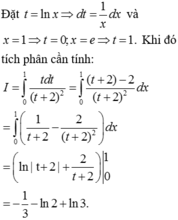Cho ∫ 1 e ln x x ln x + 2 2 d x = a + b ln 2 + c ln 3 với a, b, c là các số hữu tỷ. Giá trị của 3a + b + c bằng
A. −2.
B. −1.
C. 2.
D. 1.
Hãy nhập câu hỏi của bạn vào đây, nếu là tài khoản VIP, bạn sẽ được ưu tiên trả lời.




a) \(\int\dfrac{2dx}{x^2-5x}=\int\left(\dfrac{-2}{5x}+\dfrac{2}{5\left(x-5\right)}\right)dx=-\dfrac{2}{5}ln\left|x\right|+\dfrac{2}{5}ln\left|x-5\right|+C\)
\(\Rightarrow A=-\dfrac{2}{5};B=\dfrac{2}{5}\Rightarrow2A-3B=-2\)
b) \(\int\dfrac{x^3-1}{x+1}dx=\int\dfrac{x^3+1-2}{x+1}dx=\int\left(x^2-x+1-\dfrac{2}{x+1}\right)dx=\dfrac{1}{3}x^3-\dfrac{1}{2}x^2+x-2ln\left|x+1\right|+C\)
\(\Rightarrow A=\dfrac{1}{3};B=\dfrac{1}{2};E=-2\Rightarrow A-B+E=-\dfrac{13}{6}\)

`a)TXĐ:R\\{1;1/3}`
`y'=[-4(6x-4)]/[(3x^2-4x+1)^5]`
`b)TXĐ:R`
`y'=2x. 3^[x^2-1] ln 3-e^[-x+1]`
`c)TXĐ: (4;+oo)`
`y'=[2x-4]/[x^2-4x]+2/[(2x-1).ln 3]`
`d)TXĐ:(0;+oo)`
`y'=ln x+2/[(x+1)^2].2^[[x-1]/[x+1]].ln 2`
`e)TXĐ:(-oo;-1)uu(1;+oo)`
`y'=-7x^[-8]-[2x]/[x^2-1]`
Lời giải:
a.
$y'=-4(3x^2-4x+1)^{-5}(3x^2-4x+1)'$
$=-4(3x^2-4x+1)^{-5}(6x-4)$
$=-8(3x-2)(3x^2-4x+1)^{-5}$
b.
$y'=(3^{x^2-1})'+(e^{-x+1})'$
$=(x^2-1)'3^{x^2-1}\ln 3 + (-x+1)'e^{-x+1}$
$=2x.3^{x^2-1}.\ln 3 -e^{-x+1}$
c.
$y'=\frac{(x^2-4x)'}{x^2-4x}+\frac{(2x-1)'}{(2x-1)\ln 3}$
$=\frac{2x-4}{x^2-4x}+\frac{2}{(2x-1)\ln 3}$
d.
\(y'=(x\ln x)'+(2^{\frac{x-1}{x+1}})'=x(\ln x)'+x'\ln x+(\frac{x-1}{x+1})'.2^{\frac{x-1}{x+1}}\ln 2\)
\(=x.\frac{1}{x}+\ln x+\frac{2}{(x+1)^2}.2^{\frac{x-1}{x+1}}\ln 2\\ =1+\ln x+\frac{2^{\frac{2x}{x+1}}\ln 2}{(x+1)^2}\)
e.
\(y'=-7x^{-8}-\frac{(x^2-1)'}{x^2-1}=-7x^{-8}-\frac{2x}{x^2-1}\)

\(a,y'=8x^3-9x^2+10x\\ \Rightarrow y''=24x^2-18x+10\\ b,y'=\dfrac{2}{\left(3-x\right)^2}\\ \Rightarrow y''=\dfrac{4}{\left(3-x\right)^3}\)
\(c,y'=2cos2xcosx-sin2xsinx\\ \Rightarrow y''=-5sin\left(2x\right)cos\left(x\right)-4cos\left(2x\right)sin\left(x\right)\\ d,y'=-2e^{-2x+3}\\ \Rightarrow y''=4e^{-2x+3}\)

a) Điều kiện: \(\left\{{}\begin{matrix}4x+2>0\\x-1>0\\x>0\end{matrix}\right.\)
Hay là: \(x>1\)
Khi đó biến đổi pương trình như sau:
\(\ln\dfrac{4x+2}{x-1}=\ln x\)
\(\Leftrightarrow\dfrac{4x+2}{x-1}=x\)
\(\Leftrightarrow4x+2=x\left(x-1\right)\)
\(\Leftrightarrow x^2-5x-2=0\)
\(\Leftrightarrow\left[{}\begin{matrix}x_1=\dfrac{5+\sqrt{33}}{2}\\x_2=\dfrac{5-\sqrt{33}}{2}\left(loại\right)\end{matrix}\right.\)
Vậy nghiệm của phương trình là: \(x=\dfrac{5+\sqrt{33}}{2}\)
b) Điều kiện: \(\left\{{}\begin{matrix}3x+1>0\\x>0\end{matrix}\right.\)
Hay là: \(x>0\)
Biến đổi phương trình như sau:
\(\log_2\left(3x+1\right)\log_3x-2\log_2\left(3x+1\right)=0\)
\(\Leftrightarrow\log_2\left(3x+1\right)\left(\log_3x-2\right)=0\)
\(\Leftrightarrow\left[{}\begin{matrix}\log_2\left(3x+1\right)=0\\\log_3x=2\end{matrix}\right.\)
\(\Leftrightarrow\left[{}\begin{matrix}3x+1=2^0\\x=3^2\end{matrix}\right.\)
\(\Leftrightarrow\left[{}\begin{matrix}x=0\left(loại\right)\\x=9\end{matrix}\right.\)
Vậy nghiệm là x = 9.

a, ĐK: \(x+1>0\Leftrightarrow x>-1\)
\(log\left(x+1\right)=2\\ \Leftrightarrow x+1=10^2\\ \Leftrightarrow x+1=100\\ \Leftrightarrow x=99\left(tm\right)\)
b, ĐK: \(\left\{{}\begin{matrix}x-3>0\\x>0\end{matrix}\right.\Rightarrow x>3\)
\(2log_4x+log_2\left(x-3\right)=2\\ \Leftrightarrow log_2x+log_2\left(x-3\right)=2\\ \Leftrightarrow log_2\left(x^2-3x\right)=2\\ \Leftrightarrow x^2-3x=4\\ \Leftrightarrow x^2-3x-4=0\\ \Leftrightarrow\left(x+1\right)\left(x-4\right)=0\\ \Leftrightarrow\left[{}\begin{matrix}x=-1\left(ktm\right)\\x=4\left(tm\right)\end{matrix}\right.\)
c, ĐK: \(x>1\)
\(lnx+ln\left(x-1\right)=ln4x\\ \Leftrightarrow ln\left[x\left(x-1\right)\right]-ln4x=0\\ \Leftrightarrow ln\left(\dfrac{x-1}{4}\right)=0\\ \Leftrightarrow\dfrac{x-1}{4}=1\\ \Leftrightarrow x-1=4\\ \Leftrightarrow x=5\left(tm\right)\)
d, ĐK: \(\left\{{}\begin{matrix}x^2-3x+2>0\\2x-4>0\end{matrix}\right.\Rightarrow x>2\)
\(log_3\left(x^2-3x+2\right)=log_3\left(2x-4\right)\\ \Leftrightarrow x^2-3x+2=2x-4\\ \Leftrightarrow x^2-5x+6=0\\ \Leftrightarrow\left(x-2\right)\left(x-3\right)=0\\ \Leftrightarrow\left[{}\begin{matrix}x=2\left(ktm\right)\\x=3\left(tm\right)\end{matrix}\right.\)

a) Bất phương trình đã cho tương đương với hệ sau:


Vậy tập nghiệm là (−1;0) ∪ (7/2; + ∞ )
b) Tương tự câu a), tập nghiệm là (1/10; 5)
c) Đặt t = log 2 x , ta có bất phương trình 2 t 3 + 5 t 2 + t – 2 ≥ 0 hay (t + 2)(2 t 2 + t − 1) ≥ 0 có nghiệm −2 ≤ t ≤ −1 hoặc t ≥ 1/2
Suy ra 1/4 ≤ x ≤ 1/2 hoặc x ≥ 2
Vậy tập nghiệm của bất phương trình đã cho là: [1/4; 1/2] ∪ [ 2 ; + ∞ )
d) Bất phương trình đã cho tương đương với hệ:


Vậy tập nghiệm là (ln(2/3); 0] ∪ [ln2; + ∞ )

\(\int\left(3x^2-2x-4\right)dx=x^3-x^2-4x+C\)
\(\int\left(sin3x-cos4x\right)dx=-\dfrac{1}{3}cos3x-\dfrac{1}{4}sin4x+C\)
\(\int\left(e^{-3x}-4^x\right)dx=-\dfrac{1}{3}e^{-3x}-\dfrac{4^x}{ln4}+C\)
d. \(I=\int lnxdx\)
Đặt \(\left\{{}\begin{matrix}u=lnx\\dv=dx\end{matrix}\right.\) \(\Rightarrow\left\{{}\begin{matrix}du=\dfrac{dx}{x}\\v=x\end{matrix}\right.\)
\(\Rightarrow u=x.lnx-\int dx=x.lnx-x+C\)
e. Đặt \(\left\{{}\begin{matrix}u=x\\dv=e^xdx\end{matrix}\right.\) \(\Rightarrow\left\{{}\begin{matrix}du=dx\\v=e^x\end{matrix}\right.\)
\(\Rightarrow I=x.e^x-\int e^xdx=x.e^x-e^x+C\)
f.
Đặt \(\left\{{}\begin{matrix}u=x+1\\dv=sinxdx\end{matrix}\right.\) \(\Rightarrow\left\{{}\begin{matrix}du=dx\\v=-cosx\end{matrix}\right.\)
\(\Rightarrow I=-\left(x+1\right)cosx+\int cosxdx=-\left(x+1\right)cosx+sinx+C\)
g.
Đặt \(\left\{{}\begin{matrix}u=lnx\\dv=xdx\end{matrix}\right.\) \(\Rightarrow\left\{{}\begin{matrix}du=\dfrac{dx}{x}\\v=\dfrac{1}{2}x^2\end{matrix}\right.\)
\(\Rightarrow I=\dfrac{1}{2}x^2.lnx-\dfrac{1}{2}\int xdx=\dfrac{1}{2}x^2.lnx-\dfrac{1}{4}x^2+C\)

a: ĐKXĐ: \(4x-3>0\)
=>x>3/4
\(log_5\left(4x-3\right)=2\)
=>\(log_5\left(4x-3\right)=log_525\)
=>4x-3=25
=>4x=28
=>x=7(nhận)
b: ĐKXĐ: \(x\ne0\)
\(log_2x^2=2\)
=>\(log_2x^2=log_24\)
=>\(x^2=4\)
=>\(\left[{}\begin{matrix}x=2\left(nhận\right)\\x=-2\left(nhận\right)\end{matrix}\right.\)
c: ĐKXĐ: \(x\notin\left\{-\dfrac{1}{2};\dfrac{3}{2}\right\}\)
\(\log_52x+1=\log_5-2x+3\)
=>2x+1=-2x+3
=>4x=2
=>\(x=\dfrac{1}{2}\left(nhận\right)\)
d: ĐKXD: \(x\notin\left\{3\right\}\)
\(ln\left(x^2-6x+7\right)=ln\left(x-3\right)\)
=>\(x^2-6x+7=x-3\)
=>\(x^2-7x+10=0\)
=>(x-2)(x-5)=0
=>\(\left[{}\begin{matrix}x=2\left(nhận\right)\\x=5\left(nhận\right)\end{matrix}\right.\)
e: ĐKXĐ: \(x\notin\left\{\dfrac{1}{5};2\right\}\)
\(log\left(5x-1\right)=log\left(4-2x\right)\)
=>5x-1=4-2x
=>7x=5
=>\(x=\dfrac{5}{7}\left(nhận\right)\)

\(a,A=ln\left(\dfrac{x}{x-1}\right)+ln\left(\dfrac{x+1}{x}\right)-ln\left(x^2-1\right)\\ =ln\left(\dfrac{x}{x-1}\cdot\dfrac{x+1}{x}\right)-ln\left(x^2-1\right)\\ =ln\left(\dfrac{x+1}{x-1}\right)-ln\left(x^2-1\right)\\ =ln\left(\dfrac{x+1}{x-1}\cdot\dfrac{1}{x^2-1}\right)\\ =ln\left[\dfrac{1}{\left(x-1\right)^2}\right]\\ =2ln\left(\dfrac{1}{x-1}\right)\)
\(b,21log_3\sqrt[3]{x}+log_3\left(9x^2\right)-log_3\left(9\right)\\ =7log_3\left(x\right)+log_3x^2+log_39-log_39\\ =7log_3x+2log_3x\\ =9log_3x\)